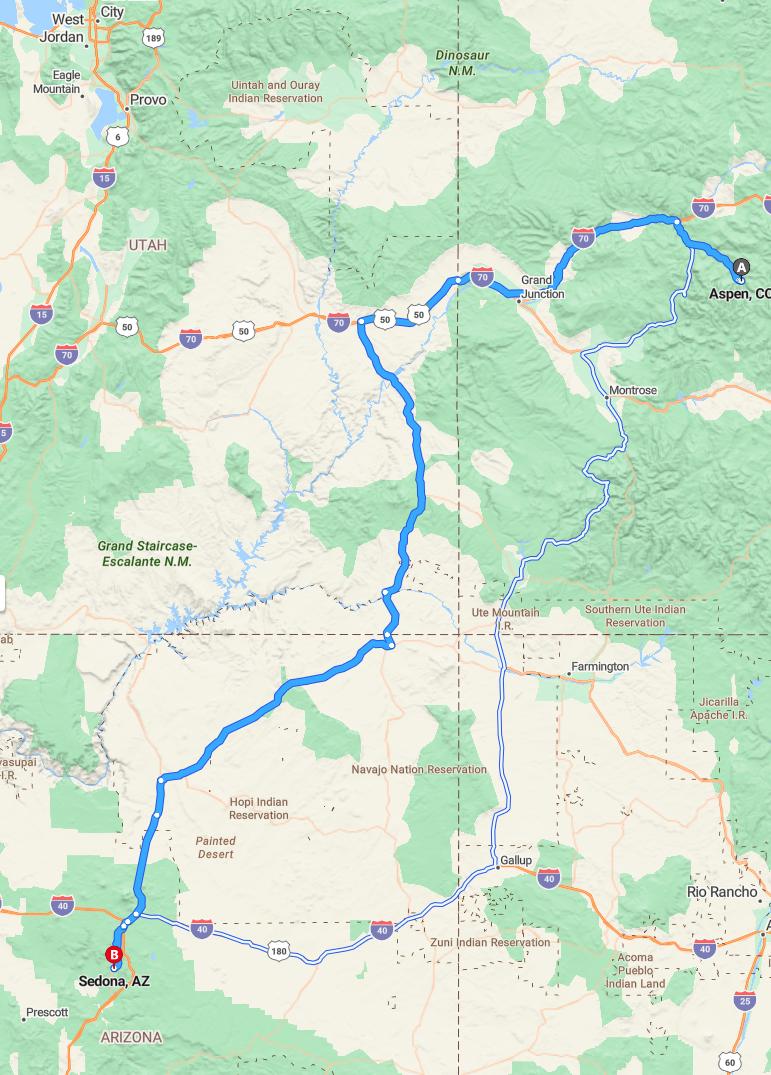Distance and estimated driving time
The drive from Aspen to Sedona spans approximately 591 miles and is estimated to take around 9 hours and 22 minutes, offering a scenic route through diverse landscapes. Traveling primarily via I-70 W and US-191 S, the trip provides an opportunity to enjoy the changing terrain from the mountainous region of Aspen to the desert vistas of Sedona. It is advisable to plan for rest breaks along the way, given the duration of the journey. Ensuring your vehicle is well-prepared will enhance safety and comfort during this scenic cross-state adventure.
Driving route
Embarking on the scenic drive from Aspen, Colorado, to Sedona, Arizona, offers travelers a diverse and breathtaking journey through the American Southwest. Starting in Aspen, you'll pass through the vibrant city of Grand Junction, known for its stunning vineyards and natural beauty, before heading south toward Montrose with its picturesque mountain vistas. Continuing your route, you'll traverse the Navajo Nation Reservation, providing a unique cultural experience along with striking landscapes. Finally, arriving in Sedona, you'll be greeted by its famous red rock formations and vibrant arts scene, making the road trip a memorable adventure. This route combines natural splendor, cultural richness, and dynamic landscapes, perfect for outdoor enthusiasts and explorers alike.

Scenic attractions along the route
The drive from Aspen to Sedona offers travelers a stunning array of scenic attractions that showcase the diverse beauty of the region. Starting in Aspen, visitors can enjoy breathtaking mountain vistas and lush forests, transitioning into the expansive plains and dramatic red rock formations of the Navajo Nation Reservation. En route through Grand Junction and Montrose, travelers are treated to striking canyon landscapes, vineyards, and the scenic views of the Colorado River. As the journey concludes in Sedona, the vibrant red sandstone formations and spiritual vortex sites provide a captivating and awe-inspiring finale to this visually spectacular road trip.
Best time to travel from Aspen to Sedona
The optimal time to travel from Aspen to Sedona is during the fall months, from late September to October, when the autumn foliage enhances the scenic drive with vibrant colors. Spring, particularly April and May, offers mild temperatures and blooming landscapes, making for a pleasant journey. Avoid the peak summer months of June through August, as the area experiences high temperatures and increased tourist crowds. Additionally, winter travel is possible but requires caution due to potential snow and icy road conditions, especially through higher elevations like Montrose and Navajo Nation Reservation.
Road conditions and potential hazards
Driving from Aspen to Sedona offers a scenic journey through diverse terrains, but travelers should remain vigilant regarding road conditions and potential hazards. Mountain passes near Aspen and Montrose may experience snow or ice, especially in cooler months, making them potentially slick and requiring cautious driving. As you pass through the Navajo Nation Reservation, be prepared for variable roadway conditions and possible reduced visibility due to weather or ongoing construction. Ultimately, staying alert for changing weather, maintaining safe speeds, and being aware of wildlife or other obstacles will ensure a safer and more enjoyable trip.
Vehicle preparation tips for long drives
Before embarking on a long drive from Aspen to Sedona, it's essential to thoroughly prepare your vehicle to ensure safety and comfort. Check the tire pressure, tire tread, and fluid levels, including oil, coolant, and windshield washer fluid, to prevent any mechanical issues on the way. Ensure your brakes are functioning properly and inspect your belts and hoses for wear. Additionally, pack an emergency kit with essentials such as a first aid kit, flashlight, and basic tools, and keep your phone charged for navigation and communication purposes throughout your journey.
Rest stops and available amenities
Along the drive from Aspen to Sedona, travelers will find several convenient rest stops and amenities to enhance their journey. In Grand Junction and Montrose, various parks, cafes, and gas stations offer opportunities to refuel and relax. As you pass through the Navajo Nation Reservation, there are designated rest areas with basic facilities, though options may be more limited compared to city stops. Upon reaching Sedona, numerous resorts, restaurants, and visitor centers provide welcoming amenities to explore the scenic beauty and unwind after the long drive.
Local weather forecast for travel days
Traveling from Aspen to Sedona through Colorado and Arizona requires considering varying weather conditions along the route. In Aspen and Grand Junction, travelers can expect cold temperatures, potential snowfall, and winter driving conditions, especially during early mornings and evenings. Montrose typically experiences moderate winter weather, but sudden snowstorms are possible, so caution is advised. As you approach the Navajo Nation Reservation and Sedona, the weather tends to be milder, with higher chances of clear skies and daytime temperatures suitable for travel, but it's important to stay updated on local forecasts to ensure a safe journey.
Alternative routes and detours
Travelers driving from Aspen to Sedona can explore alternative routes and detours to enhance their journey. An option is taking the scenic Highway 50 through Montrose and Grand Junction, offering stunning river and mountain views. Alternatively, detouring through the Navajo Nation Reservation provides a cultural experience, with stops at indigenous art sites and local attractions. These routes not only diversify the travel experience but also provide opportunities to discover hidden gems along the way.
Travel safety tips for mountain and desert environments
When traveling through mountain and desert environments, it is essential to prioritize safety by preparing adequately for changing weather conditions and altitude variations. Make sure your vehicle is well-maintained, with sufficient fuel, and carry emergency supplies such as water, food, and a first aid kit. During mountain drives, be cautious of steep slopes, sharp turns, and potential wildlife crossings, while in desert areas like Navajo Nation Reservation, stay hydrated, protect yourself from sun exposure, and avoid overheating. Always inform someone of your travel plans and estimated arrival time to ensure help can be reached if needed in these remote regions.
